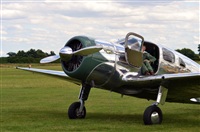 |
|
905 vistas |
|
|
|
|
|
|
|
|
|
|
|
|
|
|
Comentarios |
|
Only 34 7W Executives were built. Note able owners included aircraft designer and aviator Howard Hughes and wealthy industrialist John Paul Getty.
At least one example was received by the by LAPE (Líneas Aéreas Postales Españolas) to be used as an airliner marked as EC-AGM until requisitioned by the Spanish Republican Air Force and marked as 30+74.
|
|
|
|
|
|
|
|
|
|
|
|
|
|
|
|
|
|
|
|
|
|
Comentarios |
|
|
These two "Echo Zulu" registrations must be the only ones not on an easyJet Airbus !
|
|
|
|
|
|
|
|
|
|
|
|
|
|
|
|
|
|
|
|
|
|
Comentarios |
|
|
This Hawker Hind was delivered new to the Royal Afghan Air Force in 1938 and continued in use until the 1950s. It was presented to the Shuttleworth Collection and was collected with the help of the Ford Motor Company in 1970. The journey of 6000 miles from Kabul to Old Warden took four weeks and the team had to endure many trials before the Hind was safely in the restoration hangar. The Hind was restored, and flew again on 17 August 1981, resplendent in Afghan Air Force Markings. The Hind was repainted in 1985 to represent K5414 of 15 Squadron, Royal Air Force.
|
|
|
|
|
|
|
|
|
|
|
|
|
|
|
|
|
|
|
|
|
|
Comentarios |
|
1st of Type for AC !
G-AKIN is a Miles M.38 Messenger 2A and was built in November 1947 by Miles Aircraft at their Northern Ireland factory, the penultimate Miles-built aircraft (constructor's number 6728). Although the first private owner, in April 1948, was Captain A W B Everard of Fighting fit at fifty-five Ratcliffe Hall, Leicestershire, the Messenger became the property of the Spiller family in August 1949. Based at Sywell from April 1952, she has been there ever since, lovingly looked after and hangared to keep her in tip-top condition.
|
|
|
|
|
|
|
|
|
|
|
|
|
|
|
|
|
|
|
|
|
|
Comentarios |
|
|
Werke No. 2088 was built in 1943 by Fieseler Werke GMBH. It is a rare survivor of the early A-model. Regrettably, as is often the case with Luftwaffe aircraft, details of its wartime career are as yet unknown. As was the case with many Storch, the aircraft had a long post-war career as a French glider tug. Acquired as a basket case by RLM Aviation Fairoaks, its restoration was well advanced when ownership passed to Peter Holloway in December 06. After being fully restored the aircraft made its maiden flight on 11th March 2009.
|
|
|
|
|
|
|
|
|
|
|
|
|
|
|
|
|
|
|
|
|
|
Comentarios |
|
1st of type for AC !
The de Havilland DH.88 Comet was a twin-engined British aircraft designed for the 1934 MacRobertson Air Race. Three examples took part in the race and one of them (G-ACSS) won it. The type set many aviation records during the race and afterwards, as a pioneer mail plane.
The DH.88 might have been the only wooden British high-performance monoplane, but for a shortage of metal for aircraft construction during the Second World War. Experience with the DH.88 would later be put to use in designing the DH.98 Mosquito, also a twin-engined monoplane of wooden construction.
|
|
|
|
|
|
|
|
|
|
|
|
|
|
|
|
|
|
|
|
|
|
Comentarios |
|
|
This Lysander was built in Canada and was used by the RCAF as a target tug serialled 2355. It was bought after the war by Wes Agnew a farmer, former RCAF instructor and collector of aircraft. In 1971 it was purchased by Sir William Roberts for the Strathallan Collection in Scotland. It arrived in the UK in October 1971 and was registered G-AZWT, and work commenced on restoring it. However, it was not until December 1979 that G-AZWT flew again, painted as V9441 a Lysander operated by No.309 (Polish) Squadron. It was grounded in 1986 and was purchased in 1998 by the Shuttleworth Collection. It has been fully restored, repainted and fitted with dummy long range fuel tank and ladder to represent V9367 / MA-B an aircraft of 161 Squadron, flown by Pilot Officer Peter Vaughan-Fowler on operation Apollo during the winter of 1942.
|
|
|
|
|
|
|
|
|